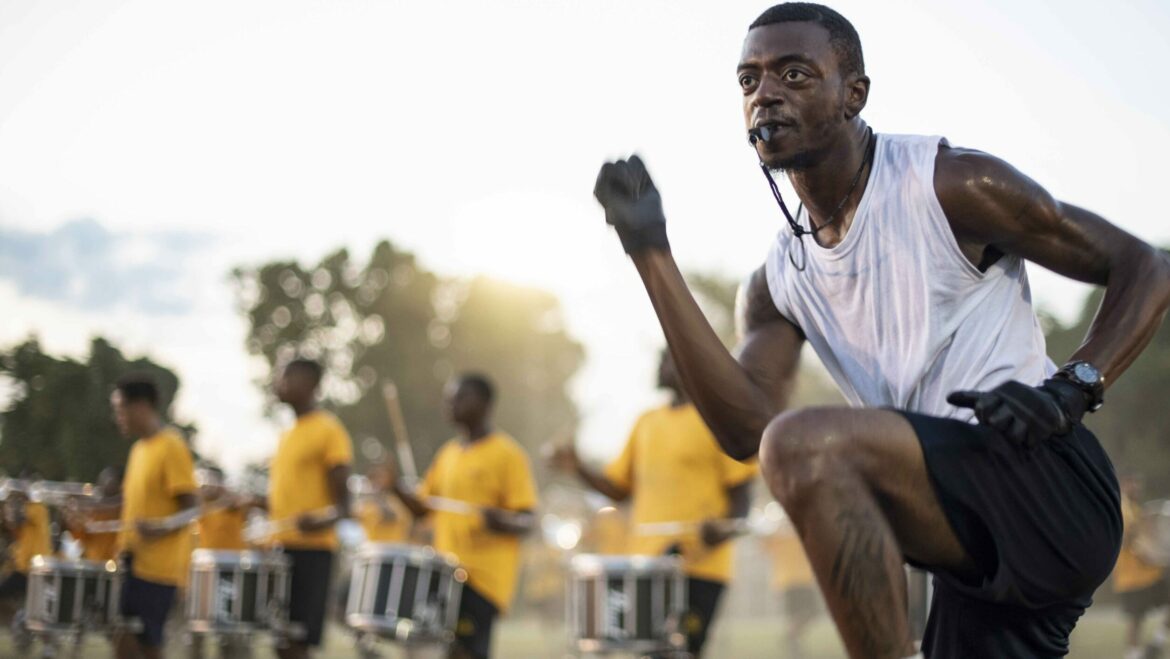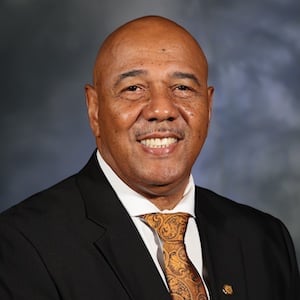Maryland Public Television builds bigger profile for HBCU Week

Maryland Public Television
Members of the North Carolina Agricultural and Technical State University marching band, the Blue & Gold Marching Machine, practice their steps in the lead-up to the HBCU's “Greatest Homecoming on Earth” festivities.
Maryland Public Television is expanding its homegrown HBCU Week program strand beyond broadcast with pilot funding from CPB.
With a one-year, $271,000 grant announced in August, MPT acquired or produced three films for national broadcast on World. Airing this month on three consecutive Sundays, each focuses on the history, reach and significance of the country’s Historically Black Colleges and Universities, says Travis Mitchell, MPT’s SVP and chief content officer. Mitchell developed the program strand four years ago as a regional celebration of HBCU history and culture.
As the broadcast footprint goes national through World, MPT also worked with teams at four stations on a package of digital shorts on HBCU “Classics,” football matchups that fuel historic intercollegiate rivalries of HBCUs like Louisiana’s Grambling State and Southern University. Each short film will be released on YouTube and PBS’ digital platforms later this month. Then the seven-minute films will be packaged together for a single episode of World’s Local, USA that debuts in February during Black History Month.
Now in its fourth year, MPT’s HBCU Week started as a celebration of all things related to HBCUs within the state network’s coverage area. The idea grew from MPT’s response to the 2020 murder of George Floyd by Minneapolis police, according to Mitchell. The senior leadership team and staff developed the “Standing Against Racism” initiative, a 10-point plan that laid out how MPT could reach impacted communities and sustain those efforts past the immediate crisis. The aim, Mitchell says, was to “foster unity through dialogue.”
A graduate of Baltimore’s Morgan State University, Mitchell came up with the idea to focus on HBCUs. Most are located within the Mid-Atlantic and Southern U.S., and there are six within the state network’s immediate reach. These include Howard University in Washington, D.C.; Morgan State; Bowie State University in Prince George’s County, Md.; and the University of Maryland Eastern Shore in Princess Anne. Mitchell recognized the value that MPT’s relationship with the universities could bring, especially if the station projected messages of hope in times of deep despair.

“HBCUs were funded by people whose generosity was brought forth to address the national blight of slavery,” Mitchell says. “They were making money available to create new schools to educate newly freed slaves,” which in the beginning meant providing elementary and secondary education. HBCUs later “morphed” into post-secondary education and professional schools. “I thought that telling the stories — not only the history, but the contemporary relevance of HBCUs — would help build relationships with that specific community, which has done so much for so many.”
Potential to have ‘lasting impact’
Though the 107 HBCUs make up only about 3% of U.S. colleges and universities, about 10% percent of all Black students choose to matriculate at HBCUs and almost 20% of Black college graduates are HBCU alumni, according to the United Negro College Fund. Moreover, the Associated Press reports that about half of all Black school teachers earned degrees from an HBCU.
When MPT launched its first HBCU Week in fall 2020, station leaders began talking with grant-makers at CPB and other potential partners about how to build their regional theme week into an approach that would resonate with audiences beyond MPT’s reach, according to Mitchell. Earlier this year, MPT proposed a pilot project that included cross-regional team-ups and a plan to work toward greater digital reach. CPB came on board in June to fund the project for one year, though MPT hopes to secure a new grant once the pilot is complete.
“We want to ensure that audiences across the country can learn about the rich history of historically Black colleges and universities and their remarkable impact that continues to this day,” said Cheraine Stanford, VP of CPB’s television content strategy. The grant will help MPT develop a national audience as well as collaborative relationships with public media producers across the country.
“We think this project will help public media reach new audiences on multiple platforms, through its broadcast and digital components,” says Stanford. “It’s an exciting and important project with the potential to have a lasting impact.”
Adapting MPT’s regional approach
MPT kicked off its HBCU Week 2023 Sept. 4, distributing more than 27 hours of programming across its TV, social media and online platforms. The lineup, featured in prime-time on its primary broadcast channel through Sept. 9, chronicled contributions of HBCUs to science, culture, medicine, history, civil rights, music, sports and the arts, according to the press release announcing CPB’s grant. MPT’s public affairs series Direct Connection and State Circle produced special episodes focused on HBCUs.
MPT’s special coverage included the documentaries premiering nationally on World. These include Inside The CIAA, about the Central Intercollegiate Athletic Association Tournament in Baltimore, and Afro Blue: A Year In The Life, about Howard University’s vocal jazz ensemble. The lineup also ventures south with Sounds Of The Game, which looks at North Carolina Agricultural and Technical State University’s Blue and Gold Marching Machine, one of the HBCU world’s biggest and best marching bands.
Chris Hastings and his team at World hand-selected the documentaries out of a pool of about 10 shows that MPT presented regionally, picking programs that would “resonate best” with World’s audiences, Mitchell says. MPT is also working to secure rights to publish some of the HBCU programs on YouTube.
With the four short films on HBCU football “Classics,” MPT and its partners hope to find a receptive audience amongst HBCU alumni and other interested parties. MPT chose its digital partners — Howard University’s WHUT in Washington, D.C.; Louisiana Public Broadcasting; and PBS North Carolina — after conversations with a whole list of potential outlets, Mitchell says.
The Howard station was a natural fit, Mitchell says, given that it’s the only public media outlet owned and operated by an HBCU. The other two were chosen in part because of their proximity to some of the country’s biggest HBCUs.
Clarence Copeland has always been intrigued by MPT’s HBCU Week, he says, even before Louisiana Public Broadcasting was invited to participate in the project. Of course, his interest probably has something to do with his status as a proud graduate of Southern University.

“I always wondered how they were doing an HBCU Week without including Southern, which is one of the largest HBCUs in the country and — I might add — the only HBCU with a system of multiple campuses across the state,” says Copeland, LPB president and CEO. When Mitchell called to enlist LPB’s help, Copeland told him all about the 90-year history of Southern’s rivalry with Grambling State, played out annually on the gridiron of the Bayou Classic.
“I also said, ‘How can you do an HBCU series and not include Southern’s famous band, the Human Jukebox, which has played in more Super Bowls than any other college band?’” Copeland adds.
LPB Digital Media Director D. Ray Washington says he will try to fit all that — plus nods toward Southern’s history and alumni legacy — into the seven-minute short, along with an equal amount of time highlighting Grambling’s background and fanbase.
Washington knows that’s a tall order. But he plans to use the short as a launching pad for even more content about the rivalry. “I think next year we’ll have to expand this clip to become part of an hour,” he says.
On-ramp for filmmakers and viewers
MPT launched HBCU Week in 2020 with just 12 hours of content. The responses, from both audiences and filmmakers, enabled MPT to expand the programming to 22 hours last year.
MPT has become a “destination for filmmakers” who are creating content about HBCUs, Mitchell says, helping to open an “on-ramp” for new filmmakers to produce content for PBS.
HBCU Week also seems to have attracted new audiences to MPT. “Although we can’t really show a direct causal connection, we have experienced less linear TV decline in our numbers since George Floyd compared to many of our other partners within the system,” Mitchell says. MPT’s prime-time ratings increased by 11% from July 2021 to July 2023 while the national prime-time average decreased by 5%, according to an audience analysis by TRAC Media Services.
HBCU Week is MPT’s most popular multiplatform content strand. TRAC’s analysis found that HBCU-related programming drew more than 545,000 views across MPT’s digital and broadcast platforms over the past two years.
The station’s own internal tracking suggests the content reached more than 206,000 people organically across social platforms in 2022, while page views of the HBCU Week website quadrupled from visitors searching for HBCU content. In addition, promotional MPT emails that mention HBCU Week have a higher open rate than any of the station’s other marketing messages.
HBCU Week Now
To really capture the hearts and minds of the potential audience for HBCU Week, MPT prioritized digital content and engagement in its pilot. The goal is to continue building audience and funding for MPT and its station partners.
This summer, MPT intern Dave Walters, a senior at Shaw University, produced “man on the street” quizzes for the station’s Facebook and Instagram accounts. Student leaders from regional HBCU campuses co-hosted the videos at their schools, asking questions about famous alums or the history of their HBCU. The videos invited viewers to respond using the hashtag #HBCUWeekMD.
The quizzes, which were posted last month, outperformed MPT’s typical social media posts by drawing about four times as many viewers.
MPT repackaged the clips as interstitials and aired them during its HBCU Week programming. The shorts will also live on MPT’s new YouTube channel, HBCU Week Now, which is scheduled to launch later this month around the White House’s annual HBCU Week Conference.
Mitchell wants PBS stations from across the country to produce content for the YouTube channel, he said. The goal is to provide “layer upon layer” of information about the HBCU system.
“We hope that this collaboration will help us continue to tell more stories,” he says. “MPT is committed to supporting this project as it grows across the system in the years to come.”
Correction: An earlier version of this story misidentified MPT’s initiative responding to the 2020 murder of George Floyd. It is “Standing Against Racism,” not “Outstanding Against Racism.”





